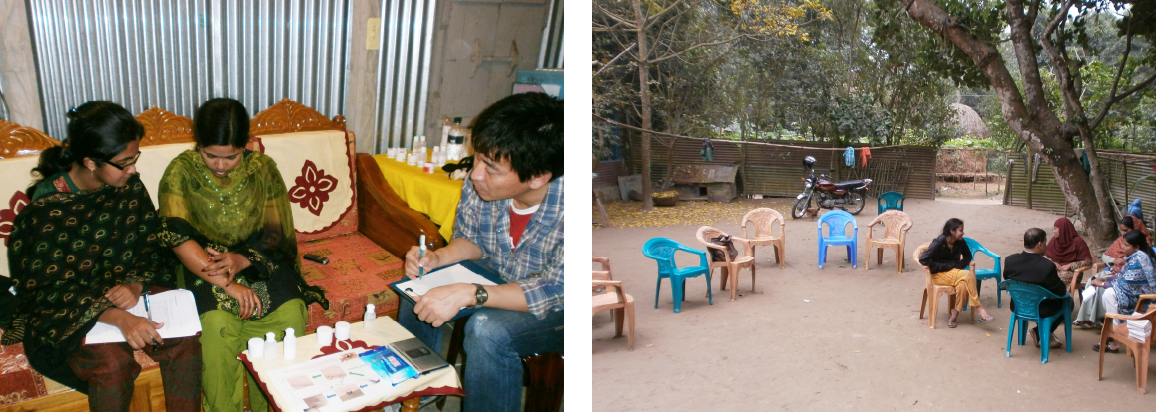ACTIONS
Innovations Born
From Diverse Perspectives
―The Secret Story
Behind the Creation of
WetForce Technology-
March 2024 (Japan)

Innovations Born
From Diverse Perspectives
―The Secret Story
Behind the Creation of
WetForce Technology-
Shiseido believes that its innovations have been created thanks in part to a corporate culture that respects diversity, equity & inclusion (DE&I) and a system that leverages diverse experiences and perspectives. As a case study, we interviewed Satoshi Yamaki, a researcher who has been advancing product development, about the background behind the creation of the world's first "WetForce" technology, developed in 2014, which strengthens the UV protection effect when exposed to water or sweat.
INDEX
01
How diverse perspectives inspired the creation of “WetForce”
What is WetForce?
Yamaki: "WetForce” is a technology that enhances the sunscreen’s water-repellent properties and strengthens the UV protection film when exposed to water or sweat, due to the minerals contained in them.
What prompted the development of this technology?
 Yamaki: In short, it was the result of thoroughly addressing the needs of people in rural areas of India and Bangladesh, which had never been considered before, and developing a product that met their needs from various perspectives, leading to the unexpected creation of this technology.
Yamaki: In short, it was the result of thoroughly addressing the needs of people in rural areas of India and Bangladesh, which had never been considered before, and developing a product that met their needs from various perspectives, leading to the unexpected creation of this technology.
In 2011, I had the opportunity to participate in the Shiseido Social Business Project, and along with several other researchers, we went to rural areas of India and Bangladesh to conduct research. The locals desired skin without wrinkles or blemishes, but upon examining the condition of their skin, we noticed significant photoaging due to the strong sunlight, and we thought that sunscreen would be effective for preventing these concerns. Furthermore, being in a very hot, humid environment where constant perspiration is common, we realized that high water resistance was required, as well as the ability to be easily washed off with soap and an affordable price point. In other words, we wanted to create a water-based sunscreen that was highly water-resistant, could be washed off with soap, and was inexpensive. Thus, development of this sunscreen was inspired by visiting rural areas in India and Bangladesh and thoroughly considering the needs of the locals.



At that time, research indicated that it was difficult to give water-based sunscreens water resistance. However, we found inspiration in the local soap that overturned this common belief. We realized that the soap had water-repellent properties due to the minerals in water and sweat. Based on this idea, we started by creating a prototype using our past product development experience with a highly water-resistant sunscreen. During the evaluation process of the prototype’s water resistance, we discovered our WetForce technology, which enhances the UV protection film with exposure to sweat and water.
02
Seizing the Path to Realization through
an Idea Contest
How did you proceed towards realization, and what was the reaction from those around you?
Yamaki: Initially, the idea was so out of the ordinary that no one could understand it when I reported it. However, when I entered it in the annual idea contest in which all researchers in the R&D area participate, it won the grand prize.
The idea contest is a competition that has been held for over 30 years, with the aim of creating new value through an unconventional process. After the proposer presents the insights, points of view, and technical features, the leaders in the R&D area judge them on the spot. It's an event where over 300 ideas on average are exhibited each year.
I won the grand prize in the idea contest in October 2012 and started considering its realization immediately. By January of the following year, the WetForce realization plan was decided, and in April, I transferred departments to focus on it and officially started the research required.
Before the transfer, I was pushing the research forward in between my regular work, which was tough, but I was greatly supported by my colleagues including an expert in analysis.
In the process of aiming for product utilization after my transfer, there was a lot of pressure from those around me. However, thanks to the coordinator from the brand team, and above all, my boss who believed it could be realized and supported me, I was able to devote enough time to development. As a result, I was able to build a prototype in eight months and complete multiple product formulations in a year. After that, thanks to collaboration with the marketing team, I was able to smoothly proceed with the product plan, and products using this technology were released within just two years.
What were your feelings as you pushed forward with the development?
Yamaki: I had a sense of mission that no one but me, the inventor, could realize my vision, and felt driven to fulfill the brand's product plan. I had a strong desire to create an innovation that would change the world, and I believed that WetForce would be such an innovation, which helped me push forward with it.
What were the results of the innovation?
Yamaki: At that time, WetForce technology was incorporated into SHISEIDO's sunscreen products, a global brand of Shiseido. After its release in 2016, sales of SHISEIDO's sunscreen products formulated with this technology became No.1 in the United States, Italy, and China, greatly increasing sales from the previous year's performance.
Now, many products using this technology have been released, and it has become an indispensable technology for Shiseido's leisure-use sun care products.

that introduced WetForce technology
in America in 2016
Ultimate Sun Protection Lotion
03
Three Points for Innovation to Occur
What do you think is necessary for innovation to occur?
Yamaki: I would like to mention three requirements.
The first is opportunities to gain diverse perspectives. In my case, I participated in a social business project at the time, and together with members other than researchers, I had the opportunity to learn about the lives, skin condition, and ways of thinking of people in South Asia for the first time. This is where the idea for this technology was born, and that would not have been possible if I had stayed in Japan.
The second requirement is the bottom-up system that I used, where anyone can propose their ideas without discrimination. I have continued to submit about 100 ideas to the contest over 10 years, and through various learning experiences, I was able to win the grand prize in the 10th year. If I hadn't applied for this idea contest, my idea would not have been shared publicly, and I don't think this technology development would have been realized. This kind of system is very important because it serves as a place where diverse and innovative ideas can be visualized.
 The third requirement is an organizational culture in which innovative ideas are accepted equally and utilized, regardless of position or hierarchy. In my case, some colleagues from other departments cooperated in the research and product development, and management showed interest in our outlandish ideas and adjusted our workload to make it possible. This innovation was able to be realized because the organization had people who accepted and tried to utilize innovative ideas resulting from diverse perspectives.
The third requirement is an organizational culture in which innovative ideas are accepted equally and utilized, regardless of position or hierarchy. In my case, some colleagues from other departments cooperated in the research and product development, and management showed interest in our outlandish ideas and adjusted our workload to make it possible. This innovation was able to be realized because the organization had people who accepted and tried to utilize innovative ideas resulting from diverse perspectives.
After the interview
After hearing from Yamaki this time, I realized again that the elements of DE&I are often behind new innovation. In this case, a new idea was born thanks to diverse perspectives through collaborative projects with people from different fields and in rural areas of India and Bangladesh, an idea contest where diverse perspectives are visualized, and others accepting and supporting unprecedented ideas regardless of hierarchy. The interview made me feel that an environment which nurtures people with diverse perspectives, strong passion, and a sense of mission is what fosters innovation.

